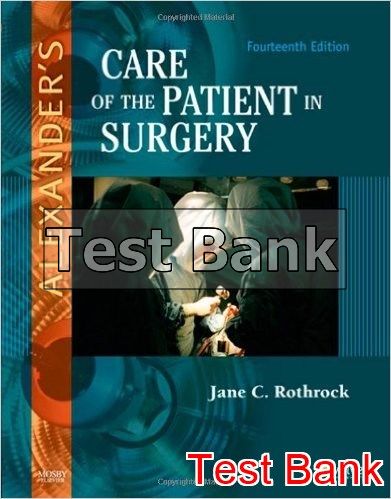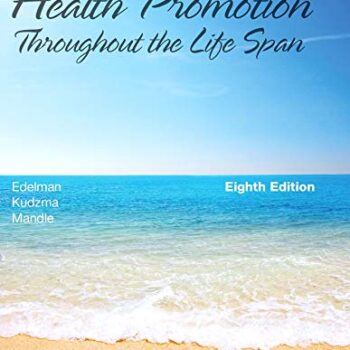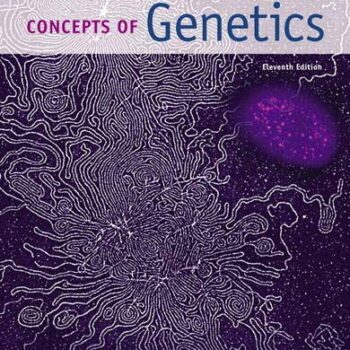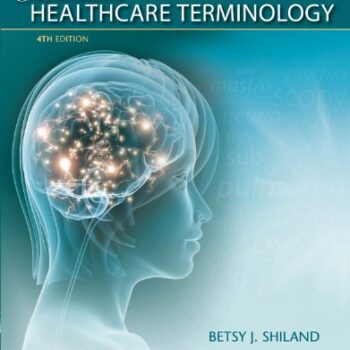
Test Bank For Alexanders Care Of the Patient in Surgery 14th Edition Rothrock
Original price was: $55.00.$19.00Current price is: $19.00.
Digital item No Waiting Time Instant DownloadISBN-13: 978-0323069168 ISBN-10: 0323069169
With the Test Bank for Alexander’s Care of the Patient in Surgery 14th Edition, it is possible to find a variety of exam questions to improve the knowledge of students regarding the care of surgical patients. This tool for revision is based on the major themes of the book, which is a step-by-step surgical guide written by Jane C. Rothrock that is meant for both the learners and the practitioners. By using these questions, one will be able to revisit complicated scenarios and do them meaningfully in the context of surgical concepts.
What’s in this Test Bank?
This Test Bank consists of a set of questions about scenarios that likely happen frequently in today’s world. Of concern are the preoperative assessments, surgical and postoperative elements, and the general emergency management needed at the hospital. Also important are infection control, wound care, and pain management, as these are essential aspects of surgical patient care.
How This Test Bank Prepares You
Using this Test Bank in preparation for surgery-related exams can improve one’s approach to studying and make it less stressful. More specifically, you can target areas of concern, develop higher-order thinking around the issues, and become more confident and competent around questions of patient safety and post-surgery outcomes. Consequently, the level of organization of this database enhances self-study as you can evaluate yourself, check your level of advancement, and find what more areas need to be self-studied.
Key Topics Covered
- Surgical Environment and Safety – Know all the setup and precautionary measures that are very important within the surgical environment.
- Patient Assessment – Work on patient assessment both pre and post-operatively relating to the assessment of recording vital signs and monitoring of symptoms.
- Anesthesia and Pain Management – Understand the various anesthetic techniques and how to control pain in patients.
- Emergency Preparedness – Learn various emergency measures including the management of unforeseen occurrences during the surgical procedure.
- Wound Care and Recovery – Review the modalities of wound care and the modalities that endorse the process of healing in postoperative patients.
Benefits of Using the Test Bank
The Test Bank for Alexander’s Care of the Patient in Surgery’s students’ knowledge will be reinforced by providing practice questions that go in line with each chapter of the textbook. It allows the users to:
- Synthesize the most important principles in surgical nursing.
- Enhance decision-making processes and skills to assimilate and employ information under duress.
- Enhance exam chances by improving the understanding and recall of vital information.
Conclusion
If you are a nursing learner, a new surgical technologist, or a practicing nurse in need of a review, having Alexander’s Care of the Patient in Surgery Test Bank is beneficial. It uses logical and exam-like questions to extensively prepare one of the surgical treatments oforthe patient. This test bank should be bought to help you improve your understanding and confidently practice in the healthcare field.
Test Bank For Alexanders Care Of the Patient in Surgery 14th Edition Rothrock
Rothrock: Alexander’s Care of the Patient in Surgery, 14th Edition
Chapter 02: Patient Safety and Risk Management
Test Bank
MULTIPLE CHOICE
1. Governmental and professional agencies and organizations, whether voluntary (governmental) or involuntary, have a significant influence on patient safety policies in the healthcare setting. Select the agency or organization statement that presents a true reflection of its focus or purpose.
|
a. |
The Joint Commission (TJC): Nonvoluntary bureau that tests healthcare institutions against evidence-based elements of performance |
|
b. |
Surgical Care Improvement Project (SCIP): Trends in surgical site infection statistics |
|
c. |
American Society of Anesthesiologists (ASA): Professional organization of anesthesia providers and technologists |
|
d. |
World Health Organization (WHO): United Nations-based and supported authority on health throughout most of the world |
ANS: D
WHO was created by and functions within the United Nations (UN) as the directing and coordinating authority for health throughout UN member nations.
REF: Page 21
2. Since its organization and establishment as a professional nursing association in the early 1950s, the Association of periOperative Registered Nurses (AORN) continues its endeavor to:
|
a. |
promote guidelines influencing patient safety. |
|
b. |
create professional OR nursing care delivery models. |
|
c. |
interpret healthcare statistics critical to perioperative nursing care. |
|
d. |
ensure risk reduction strategies are the foundation of perioperative education. |
ANS: A
The Association of Operating Room Nurses (now called the Association of periOperative Registered Nurses [AORN]) began organizing in the early 1950s. AORN’s conferences and publications were replete with patient safety information. Its first conference in 1954 included programs on methods of improvement, explosion prevention, bacteria destruction, the surgeon-nurse relationship, and positioning.
REF: Page 18
3. The perioperative environment is a dangerous place for both patients and staff. The surgical patient is at risk for harm, regardless of age, surgical diagnosis, or planned procedure. Select the physical risks.
|
a. |
Chemical, thermal, and radiation burns |
|
b. |
Anxiety and knowledge deficit |
|
c. |
Lost or mislabeled specimen |
|
d. |
Breaches of confidentiality, privacy, and dignity |
ANS: A
A physical risk is some damaging or noxious element that comes into contact with the patient to cause harm, such as an electrosurgical/laser beam, pooled prep solution, glutaraldehyde retained in an endoscope, or a foreign object.
REF: Pages 34, 37-38
4. Sara Martin, a healthy 32-year-old nursing student, is scheduled for excision of a left-sided subglottal cyst with a frozen section and possible radical neck dissection. In addition to comfort and caring behaviors and reassurance from the perioperative nurse to mitigate Sara’s nervousness and fears, the admission process provides the opportunity to collect and verify information about the patient to ensure patient safety. Among the patient data that must be verified are:
|
a. |
allergies, history, and physical report, and level of anxiety. |
|
b. |
lab and imaging results, and blood transfusion orders. |
|
c. |
signed consent, advance directives, and personal belongings. |
|
d. |
All of the options must be verified. |
ANS: D
Key features of the Universal Protocol for perioperative patient care are performing a preoperative verification process, marking the operative site, and conducting a “time out” immediately before starting the procedure. A properly performed “time out” includes information about the patient and the procedure.
REF: Page 19
5. Sara was positioned, prepped, and draped following general endotracheal anesthesia induction. The team assembled around Sara and the sterile field to perform the time-out as described in the WHO surgical checklist. Successful employment of the time-out can only be ensured when:
|
a. |
the time-out is initiated by the surgeon. |
|
b. |
the entire team stops and focuses their attention together. |
|
c. |
perioperative services have a physician champion and surgeon buy-in. |
|
d. |
someone simultaneously checks the patient’s ID band. |
ANS: B
All members of the team must introduce themselves by name and role and participate in sharing critical elements of care. The team includes the surgeon, anesthesia provider, and nursing staff, plus any allied or ancillary care providers contributing to the procedure when the time-out is performed.
REF: Pages 21, 24
6. When unexpected events occur that have or could have, compromised patient safety, a systematic investigatory process takes place. Significant information is gained through this meticulous exploration. The primary motive for carrying out a root cause analysis is to:
|
a. |
establish cause and trends based on who was involved. |
|
b. |
determine precisely what happened and why. |
|
c. |
find out what needs to take place to prevent a recurrence of the event. |
|
d. |
uncover factors that contributed to the environment and the event. |
ANS: C
Root cause analysis is a systematized process to identify variations in performance that cause, or could cause a sentinel event. The analysis phase of root cause analysis progresses from “why” questions to “what can be done to prevent this” questions that flow and ultimately result in an action plan. Root cause analysis concentrates on systems and processes, not individuals.
REF: Page 19
7. The National Patient Safety Goals (NPSG) are intimately aligned with perioperative nursing-sensitive interventions that define the daily role functions of the perioperative nurse. In the early days of the twentieth century (1900s), as perioperative nursing evolved as a specialty of nursing practice, history was chronicled when someone remarked that: ____________________________________________________________________.
Select the quote that best relates perioperative nursing care to the NPSG.
|
a. |
“Surgical nurses are the glue that holds surgical care together.” |
|
b. |
“A nurse is always there to be the patient’s advocate.” |
|
c. |
“The primary role of the surgical nurse is to protect the patient from the surgery.” |
|
d. |
“Primum non nocere” (first do no harm).” |
ANS: C
Most perioperative nursing interventions are aimed at protecting patients from the unintended insults of regular surgical care and the risks inherent in surgery. Tightly coupled systems are most prone to accidents, and surgical suites, emergency departments, and intensive care units are examples of complex, tightly coupled systems.
REF: Pages 18-20
8. After Sara Martin emerged from anesthesia and was extubated, she was transferred to the PACU by the anesthesia provider and perioperative nurse. She had an excision of a benign subglossal cyst. A hand-off report was given to the accepting PACU nurse. The anesthesia provider and perioperative nurse described the procedure, allergies, weight in kilograms, intake and fluid loss, anesthetics and medications, pain, and several other critical parameters of physiologic status. Choose the answer below that completes the blanks in this sentence: _________________________ is the first element of information that should be shared in the hand-off report; the ______________________ has the responsibility for the ultimate transfer of information.
|
a. |
PACU bed space number; anesthesia provider |
|
b. |
The names and roles of the perioperative nurse and anesthesia provider; receiving PACU nurse |
|
c. |
Patient identification; receiving PACU nurse |
|
d. |
Patient identification; anesthesia provider |
ANS: C
All patient encounters should begin with patient identification verification. The receiving healthcare provider bears the responsibility of obtaining all of the information needed to safely care for the patient before the transferring staff leaves the area. Time for clarification and questioning must be provided. The purpose of hand-off communication and reports is to provide essential, up-to-date, and specific information about the patient. Standardized hand-off communication must include an opportunity to ask and respond to questions.
REF: Page 26
9. The OR is a danger-prone area for both patients and staff. Providing a safe environment of care for the patient involves identifying, mitigating, and managing the hazards inherent in surgical care. Choose the answer below that completes the blanks in this sentence: The risk of the surgical hazard of _________________ can be mitigated through ________________________.
|
a. |
Wrong patient, wrong site, and wrong side surgery; site marking and presurgical checklists |
|
b. |
Electrical and thermal burns; alcohol-free prep solution |
|
c. |
Surgical site infection; flash sterilization |
|
d. |
Surgical airway fire; fire extinguishers in every OR |
ANS: A
Evidence shows that wrong-site surgery not only can devastate the patient and family but also can impact the perioperative team adversely. All institutions accredited by TJC must follow the Universal Protocol for Preventing Wrong Site, Wrong Procedure, and Wrong Person Surgery. The surgical team must agree that this is the correct patient and that the planned procedure is on the specified side and site. Marking the surgical site must be done so that the intended site of incision or insertion is unambiguous.
REF: Page 31
10. Laparoscopic procedures that emergently convert to open procedures place the patient at risk for unintentional retained foreign objects (RFOs). What new and evolving risk reduction strategy could prevent RFOs and frustrating, time-consuming miscount adventures at the end of these procedures?
|
a. |
Creating pre-counted laparotomy sets with only a few necessary instruments. |
|
b. |
Performing radiologic surveillance on all conversion procedures at closure |
|
c. |
Counting all instruments including a laparotomy set before the laparoscopy |
|
d. |
Replacing or tagging sponges and laparotomy instruments with RFID chips |
ANS: D
At a minimum, all facilities should have a “count” policy that reflects AORN’s Recommended Practices for Sponge, Sharp, and Instrument Counts. While standard counting prevented 82% of retained sponges, bar-coded and RFID-tagged sponges prevented about 97.5% of retained sponges. The bar-coded sponges were the most cost-effective. Researchers suggest that, given medical and liability costs of more than $200,000 per incident, sponge tracking technologies can substantially reduce the incidence of retained surgical sponges at an acceptable cost.
REF: Page 34






